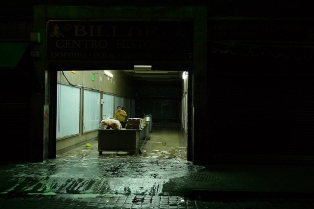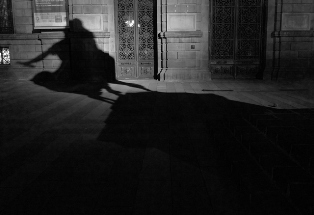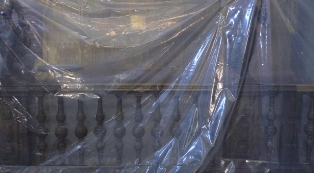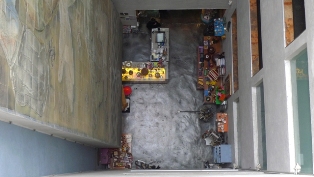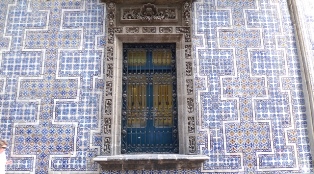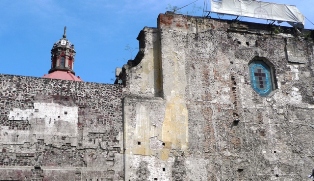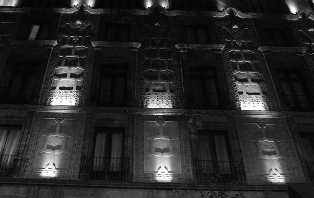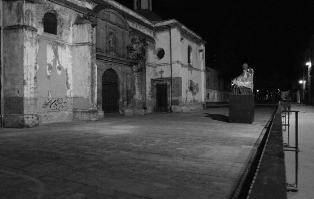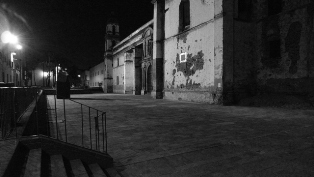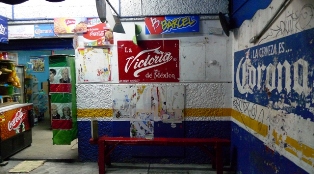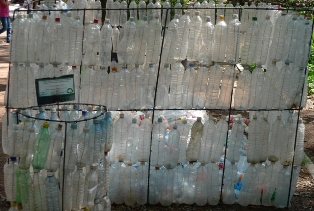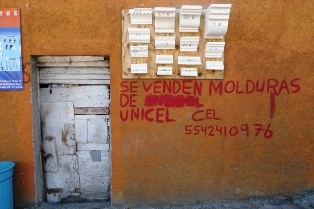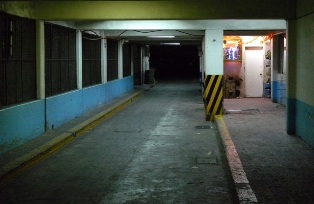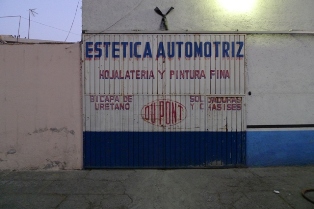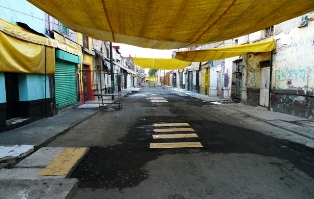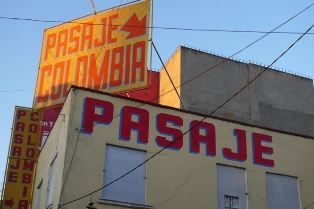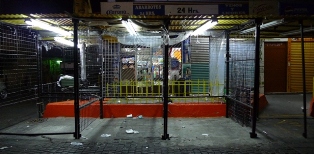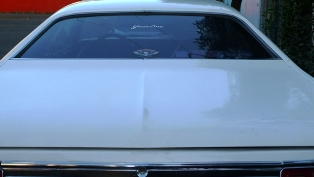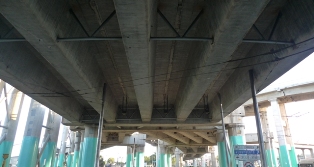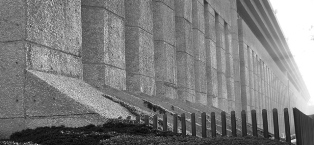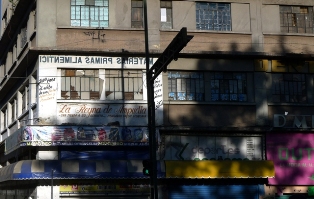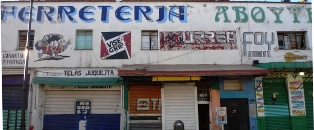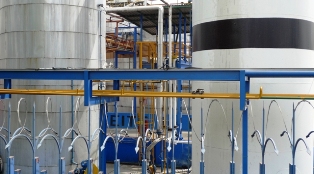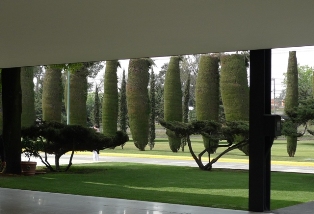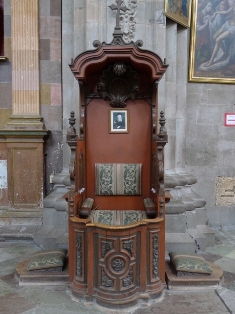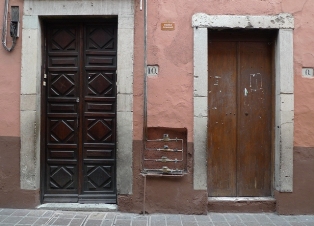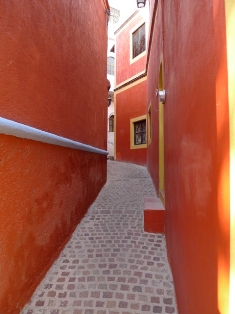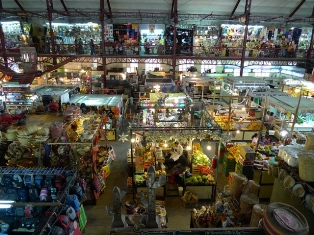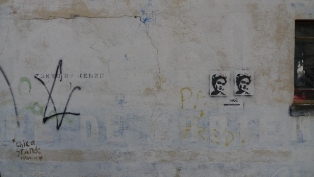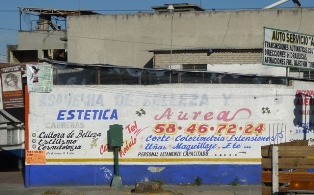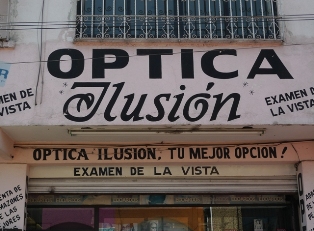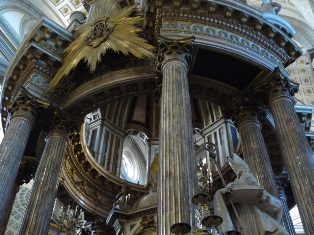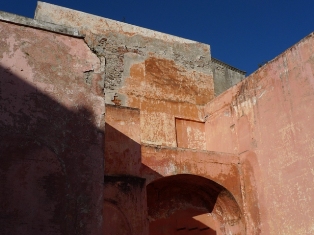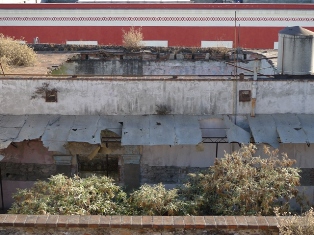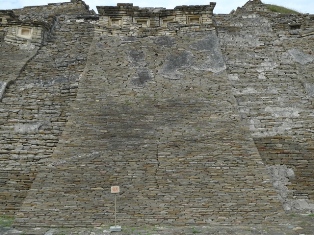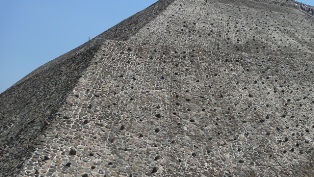It is not easy to characterize Mexico city. The character I describe can be no more than the product of what I select and what I am able to make my own. And once I have made something my own, what is it exactly I am describing? And then in describing it, the character of my Mexico city forms an assemblage with you the reader. What is this Mexico city that is left? It is not a thing, it is a multiple-city a city of events folded into our experience of things. It has so many stories to it already, an infinite number of stories are possible. Mine are determined by a series of early morning walks starting at 5.30 in the morning and ending at about 8 with my friend and colleague Sjef: Westwards, Northwards, Southwards and Eastwards, the grid is unrelenting it allows no deviation except by 90 degrees.
The first excursion was timid and hesitant, too inhibited by myth and warning. In fact it was somewhat intimidating. We had only arrived the evening before, when it was already dark and all the shops around our hostel, situated behind the cathedral just beyond the Zocalo, had shut up for the day. The city we came across was desolate, bolstered by stories of danger and threat that tend to surface quickly in conversations about Mexico.
All the shops were heavily shuttered. The streets were doubly empty: there were no people and there was no apparent reason for any to be there. The shutters had something furtive; they are not simple blind shutters, doing their business going up and down, at the centre they have a small low door cut into the metal sheeting and bolted with three of four heavy padlocks. Passageways charged with apotropeic magic. The streets, with their high wide and generous pavements were empty and clean. I did make a good photograph, two i fact, although one is technically so deficient it is impossible to see much of the subject: José Martí covered by tentcloth. The other is my favourite, the shadow of an equestrian bronze in front of the museum.
The next morning, while it was still dark, Sjef and I set out westward along the Tacuba, past the back of the Bellas Artes towards the Almeda park; we rounded the park and zigzagged the grid a little. Just one young sleepless man came up to us and asked us for some money but did not insist when we indicated we did not want to give any. We walked back and that was that. Nothing had happened. Then slowly the day started, shops opened and before we knew it the city had completely transformed itself into a lively bustling place full of stuff, noise, gesture and smell. We spent the day in and around the Zocalo, first we went to the Presidential Palace and looked at Diego Rivera’s view of Mexico. It has to be said, I was never quite sure why this man was so revered and I still do not know; it is propaganda, caricature, easy stuff. One leaves his murals with the sense that he criticizes regimes with a naïve optimism easily as dangerous as the regimes he criticises. Even so it was impressive in terms of scale and even honesty, after all these politically sensitive and clearly critical paintings were done in the lion’s den as it were. We then went to the cathedral and I watched the lead registering the dome’s slow shift as the whole heavy structure pushes down into the soft ground.
The next morning we were more ambitious, setting out southwards along the Isabel la Catolica and crossing the giant José Maria Izazaga. We walked on until it was light when we found ourselves in a large Cerda grid lined by endless rows of more or less personalised houses. On the way out in the dark we passed the monastery of Sor Juna placed along a delightful oblong square, bearing the signs of daily use.
On the 3rd of March we walked northwards and crossed markets, huge motorways, and endless roads with gated side-streets. We entered one and discovered that the streets are accessible by car only from the main road but that at the back of the gated side street there is, generally a small pedestrian path leading to other exits of the street block. 4 storey apartment blocks, generally well-kept with neat gardens and high wire fences containing what would appear to be very small apartments are occupied by middle class families of mums and dads who walk their children to school every day.
On Friday 4th March we went eastward and crossed the immense market halls each devoted to a specific set of produce, vegetables, delicious looking, large and fresh beautifully stacked and visited by early morning buyers haggling gently and friendlily over the price. Numberless short stocky men carrying and throwing boxes, frozen chickens and baskets of produce, stacking potatoes and laughing amongst themselves. We stopped at the meat market which was immensurate. Wet floors and the sweet sickly smell of meat surrounding us, narrow passages through the market stalls categorizing their meat and displaying it with an encyclopaedic confidence, tongues, pigs-heads, pigs trotters, giant cubes of processed compounded meat, unidentifiable stuff and among all that here and there a fish stall and cheese stalls. We walked on and on stupefied by the size of things and conscious of our wide bodies in the narrow lanes left open by stalls overflowing with meat.
The rest of the day we would join the students on our program to see all the various sites of the city. Our visit to Barragán’s houses was wonderful. Barragán’s architecture seems to be an ode to the arrangement and composition of a life where form is designed through light, shadow, colour, texture, sound and the consciousness of size, distance, height, and the movements and habits of the human body. I loved it and found it somehow moving. Especially his own house, so completely devoted to his own bachelor habits, a shrine to his delights and habits and spatial skill, simply wonderful. I love the way he composes shape using colour, creating sequences and directing our gaze though walls, screens and gaps.
I also loved our visit to Juan O’Gorman’s twin houses for Frida Kahlo and Diego Rivera. Unfortunately Kahlo’s house was not accessible, for which I was sorry as I imagine it to have been an extraordinary place. But Diego Rivera’s house did not disappoint: a fragile early modernism heavily dependent on Le Corbusier but still unsure of itself and not overconfident of how to proceed, creating curious occasionally haphazard spaces using internal balconies and a low room attached to the main living room with a gigantic glazed wall set in thin steel window frames facing the north. I loved the green simple furnishing and cabinet of curiosity that the hose represented.
On our last day we took a privately run train to the industrial heart of Mexico City in the North and visited Mies’ Bacardi Headquarters. That was fun. Or perhaps fun wasn’t quite the word. Until now we had really not experienced the endlessness of Mexico City. Travelling within the city, your horizon is kept relatively close, you are embedded in the built fabric and your gaze is framed by the immediate buildings. Only by going by train, slightly raised above the surrounding landscape could we get a sense of Mexico City’s unimaginable border-lessness, its endlessness, which is both frightening and somehow heroic. We walked the three kilometres or so from the station to the Bacardi Factory and traversed the industrial complexes accompanied by the sound of gigantic lorries making big noises as they changed gears. Seeing this wonderfully inappropriately glazed box with its Grecian love of order and stillness made me a fan of Mies again. Whenever I see his buildings I renew my vows. I love good boxes. There is nothing like his work. It was just a bit of a pity it contained people actually doing something. That, it has to be said, rather disturbed the timelessness that his buildings impose on their surroundings and their interiors.
We subsequently went by taxi to Barragan’s San Christobal and could not at first find it; we criss-crossed the area where it should have been and finally came upon the back entrance. We were met by Mss Eggstrom who was delightful and she let us have two hours of the grounds. We did not go inside the house otherwise she “would have no life”, and so this monastic place devoted to the cult of the horse was transformed in my mind from a set of picturesque tableaus in a book to a sequence of screens through which movement is made self-conscious and stylized. I liked it. I would not want to live there if I had the choice.
We then walked back and that was an important learning moment for us. We were able to join San Cristobal, representing the upper crust of Mexican society in an imaginary line to the shanty town laying against one hillside next to it. We topped the hill and then descended the other side to see an area of lower-middleclass houses, each gated individually. One of them had a very expensive red Mercedes sports car parked on its roof. We walked for more than an hour along various branches of a gigantic motorway, crossing viaducts and climbing bridge heads to eventually reach the station in the dark. It gave us a scaled sense of a socially ordered city that would not have been possible when traversing the same path by car or bus.
That evening we went to see the Shrine to the Virgin of Guadelupe and I lost my balance slightly on entering the lovely old church devoted to her story and understood that the church was slowly sinking into the soft ground upon which Mexico city was built and which determines so much of its morphology.
I twice looked for the narrow church along the Donceles, the Templo de la enseñanza, which I had visited together with some students one evening but found it closed both times. I shall have to try again next time. The church was remarkable for the churrigueresque baroque of course, but particularly for the number of saints displayed in glass boxes as if it were some sort of cabinet of curiosities showing stuffed animals.
Yesterday we took the bus to Guanajuato. Driving out of Mexico city is an experience indeed. If its endlessness had been imprinted on our imagination during the train journey, the bus journey brought it home properly. It took us more than an hour to traverse the radius from the centre to the end of the final finger of housing piercing the dry, abandoned countryside. Apparently Mexico City grows by a thousand people a day. Most of these people spend their days collecting their lives by scavenging for building materials, for food, for money while trying to maintain their dignity. Most succeed in preserving that last which is quite a feat when you consider how hard the daily slog of their life must be.
Arriving in Guanajuato the bus was constantly signalled to by young men standing on the road making urgent and imperious gestures for us to stop and let them give us their Free Tourist Guidance. We did not and were dropped off at the main Bus station after which we walked to the hostel which is where I am now sitting in a delightful spot with a light breeze after a series of three long walks through and around the city. Guanajuato is colourful and pretty with an unlikely number of festive and comfortable squares where people do much of their living. One is covered by a continuous canopy of boxed trees with a band stand at the centre; another is trapezoid but centred by a raised oblong platform with a striped pattern of natural stone. Yet another is centred by a fountain. The houses compete with each other for unlikely combinations of colour which, however make the city as a whole very pleasant to walk through. Small narrow streets wind up the hillsides. In the gully, which used to be a riverbed, and probably still is during the rainy season, a gigantic subterranean network of streets feed the city with its cars. One of the most prominent squares faces one side of a large very sober building which used to be the city’s grain silo.
Just before we left three students and I went to a museum of Mummy’s which quite honestly was just simply revolting. Dried up, leathery bodies, with an occasional worm hole or ripped skin to reveal a dense network of dusty threads, lay with their shouting faces or miserable grins in the most unseemly positions displaying their most intimate places, places they would never have wanted the world paying 50 pesos to see were propped up to appear standing or were laying in receptive positions in dirty glass cages. Families with children were happily moving from one display case to another and the children were taking pictures with their mobile phones. A pregnant woman who died and whose face screams still, had her foetus specially mounted next to her. I did not like it. But I could not help myself looking, looking especially at the Mexican families mingling with their dead so easily.
There are a couple of rather impressive neo-classical houses around the cathedral and the cathedral itself is fabulous, although the church I enjoyed most was the one next to the curious University building.
The next day we went to San Miguel de Allende. Where Guanajuato was a valley town crawling up the surrounding hills, San Miguel is a gridded town laid out in a classic way according to the laws of the Indies. Guanajuato also obeys these laws, but within the limits and possibilities set by its topography. San Miguel set at the foot of a hill within a plane has straight streets and its old centre describes a long oblong with street-names like Relox. I enjoyed wandering around it. You cannot blame a city for being pretty, even if it does mean that its very prettiness ultimately spells its death as a city to take on a role as a boutique city, of which we now have quite a few. Many of its facades have become thin screens hiding modern life, others still offer the classic patio’s and courtyards that they were conceived for. Everywhere the chewy sounds of American affluence and everywhere overpolite and overly familiar, over friendly shopkeepers trying to satisfy their addiction to a sell. I left it with a sense of sadness. Tourism and boutique-ification are facts of life, and, from an anthropological view, as interesting as any other development, and yet such processes create surfaces that bother me: doors are not just painted to care for the wood, they are painted using special techniques to look both worn and cared for. This does not work somehow. It is not that I mind about the trickery, I have nothing per se against trickery, but it is not very good trickery; it does not succeed in fooling me for a second and the final result is simply not as attractive as either a well-painted door, or a worn door. Perhaps I need to work on that. Some of the churches were quite sublime.
On the bus back to Mexico city. Just ahead of us the darkening sky is colouring orange, not from the setting sun, but from the lights of Mexico city, an oversized large collage not unlike Rivera’s encyclopaedic murals, sprawling, size-less, endless, full of social, economic, programmatic fault-lines, crossed only by guiltless streets.
Puebla
Spent a day in Puebla with my student Matthijs and Dave. Good day. Puebla is gorgeous, deserving its place on the World Heritage list. I loved the tiles, the courtyard houses, the ornaments. The beautiful churches with their wild churrigueresque mania for ornament. I love ornament!.
El Tajin
A decidedly weird place. The archeological hineininterpretation is even weirder. I don't believe much of it all. The thing i liked best was the obese temple with its sagging front.
Teotihuacán
On passing it in the bus to El Tajin, I glimpsed Teotihuacán from the road and was decidedly underwhelmed. What had I expected? I don't know. Something else. The Mexican Landscape in its totality, that is framed by the generous windows of the bus shifting past me in their dance of perspective certainly seemed to be more than this paltry little thing. I could just see the Pyramid of the Sun and behind it the majestic mountain it seemed to want to be. It had failed, that much was clear. On returning from El Tajin we stopped and were given the whole afternoon before the journey back home to explore the site. That is when it struck. I first climbed the Pyramid of the Sun to survey the whole site, which was in fact immense, windy and eery. Before the pyramid, on top of a sizeable plinth lay the remaining walls of a temple drawn like the plan of an archetypal house. The pyramid when close to it and when judged as a work of human labour is vast and the way its surfaces facet makes it even bigger when standing on top. It stands at right angles, to the east of the extraordinary central avenue dissecting the city, high on the dry plains of Mexico. Palaces like temples and temples full of an unrelenting power and threat. The avenue set low relative to all these temples and palaces must have been depressing indeed for those not in power. Sjef and I walked the full length of it avenue, first towards the south, towards the so-called temple of Quetzalcoatl and the market and then we turned on our heels and walked straight up to the pyramid of the moon in the north which imitates the mountain rising up behind it. There were hundreds or thousands of tourists and yet they were swallowed up in the immensity of it all. Only on the two pyramids did it get a little crowded. The avenue is a wonderful experience. It is not a proper street. Just south of the Pyramid of the Sun it develops square basin-like depressions connected with stairs all on axis. Descending into the basin and climbing out of it at the other side the perspective of the city shifts continually in the same subtle way as a dyke in the flat stretched landscape of Holland. You see the Pyramid of the Moon rising and waning as you ascend and descend these staircases, each time the pyramid looming up a little closer, a little more dramatically, while the sides of the avenue stand over you watching your every move. It is a cinematic experience.
